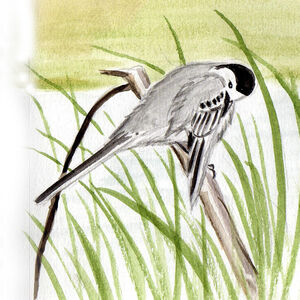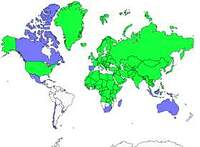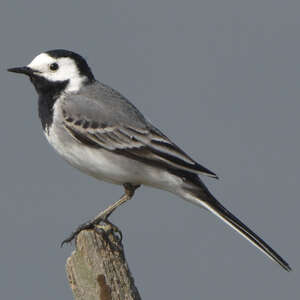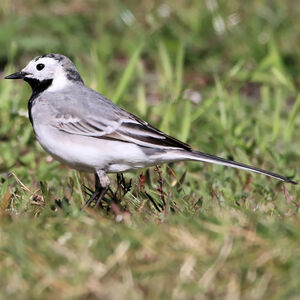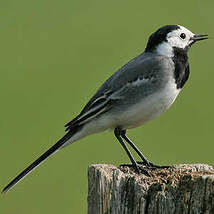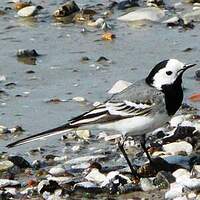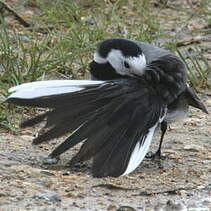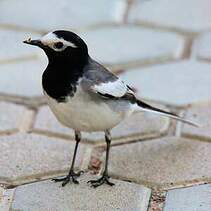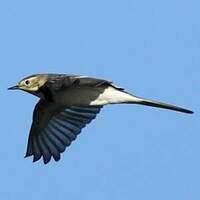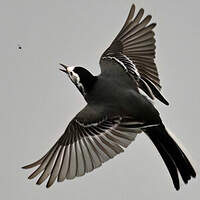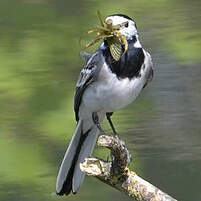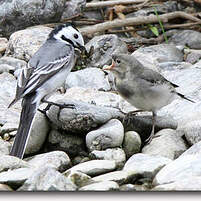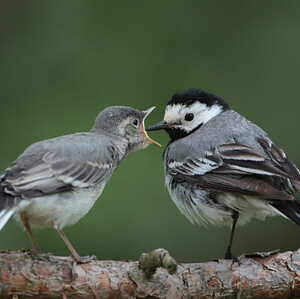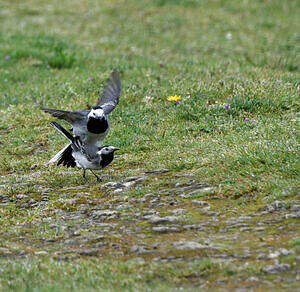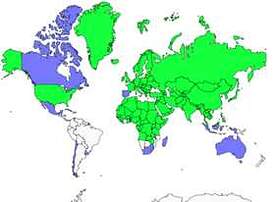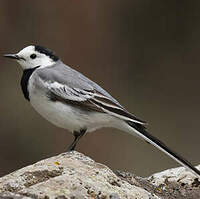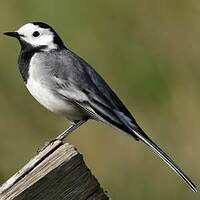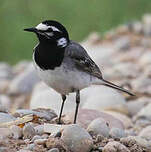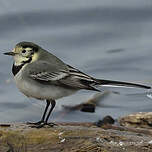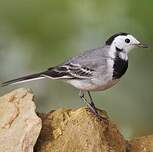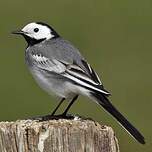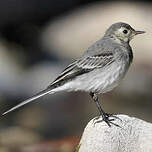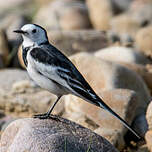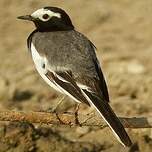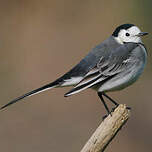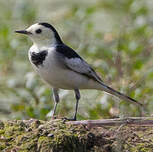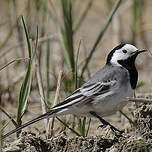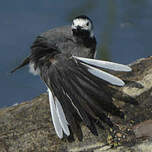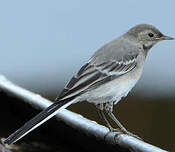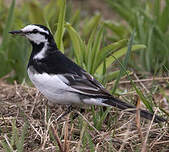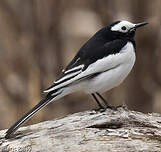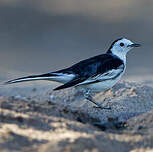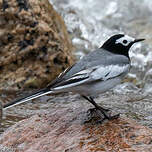White Wagtail
Motacilla alba - Bergeronnette grise
Identification
The White Wagtail is a remarkable anthropophilic bird with its long tail and short wings and its colours. It used to be called vulgarly what is now known as a hochequeues. Indeed, similar to similar to its fellows, its long tail is often moved with vertical movements. Its plumage is completely black and white and various shades of grey. There are variations according to the subspecies, but still allow for identification. Here, we will be describing the western European subspecies alba. The nuptial adult has a black and white head (back of the crown, neck, back of the neck, chin and throat black, forehead and sides of the head and neck white). A black bib occupies the chest, in continuity with the black of the throat. The eye is dark and the beak is black. The coat, back and scapulars are plain grey. The wings are contrasted. The coverts and tertiaries are blackish and edged and pointed with white, creating two clear bars in the middle of the wing. The tail is black and bordered externally by white. The belly and the under tail are white. The flanks are washed with medium grey. The legs are black. The sexual dimorphism is limited. The female has less pure blacks than the male and the limit between the black of the head and the grey of the coat is blurred. At the moment of the post-nuptial moult, the head lightens up a lot. The black area is reduced and the throat whitens. The bird will result like this throughout winter until the next molt. The juvenile has a much less contrasted plumage. Dark grey partially occupies the parts which are black in the adult. The 9 subspecies are distinguished mainly in the nuptial plumage by a different division of black and white in the head and chest and by a minor or major white presence in the wing. The male of the subspecies yarrellii of Britain and Ireland has a gleaming black coat on the back and soot grey flanks.
Subspecific information 9 subspecies
- Motacilla alba alba (se Greenland, Iceland and the Faroe Is. through continental Europe to the Ural Mts, the Caucasus, c Asia and Middle East)
- Motacilla alba yarrellii (Ireland, Britain and coastal w Europe)
- Motacilla alba subpersonata (w Morocco)
- Motacilla alba personata (n Iran to sw Siberia, w Mongolia, nw China and w Himalayas)
- Motacilla alba baicalensis (sc Siberia to ne China)
- Motacilla alba ocularis (n Siberia to nw Alaska)
- Motacilla alba lugens (coastal se Siberia and islands, n Korea and n and c Japan)
- Motacilla alba leucopsis (inland se Siberia, c and e China, s Korea and sw Japan)
- Motacilla alba alboides (c and e Himalayas to s China, n Indochina and n Myanmar)
Foreign names
- Bergeronnette grise,
- Lavandera blanca,
- alvéola-branca,
- Bachstelze,
- barázdabillegető,
- Witte Kwikstaart,
- Ballerina bianca,
- sädesärla,
- Linerle,
- trasochvost biely,
- konipas bílý,
- Hvid Vipstjert,
- västäräkki,
- Witkwikkie,
- cuereta blanca,
- Maríuerla,
- pliszka siwa,
- baltā cielava,
- bela pastirica,
- Белая трясогузка,
- ハクセキレイ,
- 白鹡鸰,
- นกอุ้มบาตร,
- 白鶺鴒,
Voice song and call
The usual call, emitted when perching or in flight, is bisyllabic - either a liquid tsi uit or ti pit, or a variation of that theme. Its song is a continuous sequence of wet-sounding warbled notes of the same pitch as the call, relatively quiet. It is reminiscent of the song of a swallow. It is uttered by the male from an exposed perch, or in flight when alerted by a passing raptor such as a Eurasian Hobby and pursued swiftly. An attentive watcher can thus be warned of the silent arrival of the predator.
Habitat
The White Wagtail occupies a wide range of open habitats, whether dry or preferably wet. Although it is not necessarily tied to water, it is often found near it.
Behaviour character trait
With its slender silhouette, long wagging tail and black and white head, the White Wagtail always attracts attention in the urban landscapes it frequents, especially since it is not particularly shy.
The male in springtime, singing in plain sight on a roof or some other elevated perch, stands out. It is also a very sociable bird outside the breeding season. You can often see them in groups in meadows or fields, especially during migration when they gather to migrate in loose troops, walking the ground and punctuating their moves with tail beats. These groups spend the night in common dorms in the trees or more rarely in reeds with their springtime cousin. In springtime, they form territorial couples who defend a few acres of land. Some wagtails even adopt alimentary territories in winter, especially when resources become scarce. The majority of the populations are migratory, but to a varying degree depending on the origin's latitude. Some are completely migratory, while others in the south of the area can be considered sedentary. Some wagtails take the risk of missing out on food in the wrong season rather than setting off on hazardous migrations.Flight
The flight of the White Wagtail, like that of all wagtails, is very undulating, alternately rapidly beating short wings on the rise and folding wings on the descent.
The typical silhouette and cries then help in the identification of the bird in flight. The relatively short wings do not allow for long migratory flights. When hunting and there are abundant flying insects, it makes rising flights in pursuit before dropping back to where it was originally. On the ground, it can bob from side to side, always to catch mobile prey.Dietfeeding habits
The White Wagtail is an insectivore in the broadest sense and feeds on all kinds of small invertebrates which vary depending on where it feeds.
Studies have shown that Diptera were always the majority in its diet because they are often naturally abundant. Coleoptera then come next, followed by other items. It uses three methods to feed. While walking, it spots insects on the ground and collects them. It can also do the same on the surface of the water on floating vegetation. At other times it runs or flies quickly towards its prey, which it takes from the ground or from a low height. Finally, it can capture insects in mid-flight and even catch them on the surface of the water while hovering. Generally, the White Wagtail swallows its prey in one go, because they are usually small insects, but it can strike the biggest or toughest ones against a stone or the ground before swallowing them. It is typical to see it feeding directly on the scraps from a landfill, which attract flies, or on a dead animal, a compost pile, seaweed or any other pile of decomposing organic matter for the same reasons.Reproduction nesting
The White Wagtail's breeding season stretches from April to July, but the timing may depend on latitude. In the temperate climate, couples have time to complete two, or even three, broods; this isn't the case in the more northern locations. First the male establishes his territory by singing from a perch such as a rooftop, then courts a female. Multiple males may battle fiercely for the same female, but it's the female who ultimately makes the decision. Following a few days of living together, mating follows. The White Wagtail builds its nest in a crevice and can accommodate a wide range of contexts.
It's often the case that this occurs in a building, under a roof, on a beam, in a crack and so on. A simple shed can suffice if it provides the right spot. Bridges are also prime locations. This environment reminds the bird of its origin in rocky places, which are often occupied in either the mountains or the plains near certain confined rivers, or in quarries. Uncommon cases often include scattered material deposits, wood stockpiles, river jams, compost bins, et cetera. The nest is sometimes built inside a nest of another species, or using its structure. Both partners take part, with the female tending to do the bulk of the work. Made with varied plant material (twigs, herbs, fibres, rootlets, moss), it is lined with hairs, wool, and feathers. The female lays five or six greyish-blue eggs, speckled with brown. Incubation lasts for around fifteen days, mostly carried out by the female. The fledgling chicks are brooded by the female for the first five days; then both adults feed them.They leave the nest after two weeks. The couple then share the siblings who will still be dependent on them for another fifteen days, but the female can start a second breeding before the first nestling is emancipated.Geographic range
The White Wagtail's breeding range spans the entire Eurasian continent in temperate, boreal, and even subtropical latitudes in Asia. To the west, it occupies Iceland and has an outpost in Greenland. To the east, it extends beyond the continent to Alaska. In the south, a particular subspecies can be found in Morocco, its only African outpost. In the north, it reaches as far as New Zemble in Russia. It breeds from sea level up to 5,000 meters in the Himalayas. In winter, the northern migratory population heads to Mediterranean and tropical regions. In Africa, it crosses the Sahara and reaches as far south as the equator in the east of the continent. It can also be found throughout the Arabian Peninsula and the south of the Asian continent, even reaching Oceania (Borneo, the Philippines). In Western Europe with its temperate, oceanic climate, it remains in small numbers in the British Isles, western France, and around the North Sea.
Threats - protection
IUCN conservation status
concern
in the Wild
threatened
evaluated
The White Wagtail is a very common to common species across most of its range. It has adapted very well to a human environment. As a result, it is not considered to be threatened.
Sources of information
- IOC World Bird List (v14.2), Gill, F and D Donsker (Eds). 2024-04-18.
- Pipits and Wagtails of Europe, Asia and North America, Alström Per and Mild Krister
- HBW Alive,
- Avibase, Lepage Denis
- xeno-canto, Sharing bird sounds from around the world,
Other sources of interest
 Specification sheet created on
06/07/2023 by Jean François
Specification sheet created on
06/07/2023 by Jean FrançoisTranslation by AI Oiseaux.net
© 1996-2025 Oiseaux.net
- Accipitriformes
- Aegotheliformes
- Anseriformes
- Apodiformes
- Apterygiformes
- Bucerotiformes
- Caprimulgiformes
- Cariamiformes
- Casuariiformes
- Charadriiformes
- Ciconiiformes
- Coliiformes
- Columbiformes
- Coraciiformes
- Cuculiformes
- Eurypygiformes
- Falconiformes
- Galliformes
- Gaviiformes
- Gruiformes
- Leptosomiformes
- Mesitornithiformes
- Musophagiformes
- Nyctibiiformes
- Opisthocomiformes
- Otidiformes
- Passeriformes
- Pelecaniformes
- Phaethontiformes
- Phoenicopteriformes
- Piciformes
- Podargiformes
- Podicipediformes
- Procellariiformes
- Psittaciformes
- Pterocliformes
- Rheiformes
- Sphenisciformes
- Steatornithiformes
- Strigiformes
- Struthioniformes
- Suliformes
- Tinamiformes
- Trogoniformes

